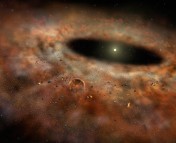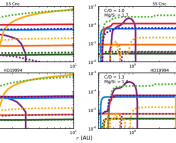Title: Depletion of gaseous CO in protoplanetary disks
Authors: Diana Powell, Peter Gao, Ruth Murray-Clay, Xi Zhang
First author’s institution: Harvard & Smithsonian, Center for Astrophysics, Cambridge, MA, USA
Status: Published in Nature Astronomy Letters, August 22, 2022, and on ArXiv on August 29, 2022
It would be super cool if we were able to watch a live broadcast of the formation of new planets. Unfortunately, protoplanetary disks, which are the birthplaces of planets, are not only far away, but are also optically thick. This means that what our telescopes can see is not the disk midplane, where we expect the majority of planet formation to occur, but only the very upper layers — the protoplanetary disk photosphere. This disk surface has presented scientists with a curious puzzle, that is that the relative abundance of carbon monoxide (CO) seems to be significantly lower as we would expect. Today’s authors present an exciting explanation for this observed depletion of CO, that draws upon the physics of CO phase transitions.
Nucleation and condensation
Since the pressure in the protoplanetary disk is so low, liquid materials don’t exist. Instead, all species exist either in the solid form (as ice), or in the gaseous state if the disk is sufficiently hot. For example, in typical protoplanetary disks, water is believed to be in the vapor phase within the innermost 3 AU where heating from the central star is stronger than in outer regions. Carbon monoxide has a much lower freezing point than water, resulting in this so-called CO snow line to be at around 30 AU.

There are two main pathways for condensation (the phase change from vapor to ice) of CO to proceed. The first one is nucleation, which occurs when the CO vapor spontaneously forms CO ice crystal. This process however requires very large concentrations of CO vapor and is therefore not likely to be the dominant process. Instead, it is much easier for CO vapor to condense out on already CO-ice-coated particles. This is called condensational growth and is also why snowflakes exist in Earth’s atmosphere: it is much easier for water molecules to condense on already formed snow crystals than to spontaneously nucleate and start a “new” snowflake.
Diffusion causes depletion
Given this context of CO condensational growth, today’s authors also consider that the turbulent gas motions in the disk mix CO vapor from the disk photosphere towards the midplane of the disk. There, it tends to be colder, so the vapor will condense on already existing CO-coated particles. Moreover, the bigger and more massive the CO ice particles become, the faster their sedimentation towards the mid-plane will proceed. For these reasons, the authors argue that CO is depleted from the observable photosphere of the disk, and instead hidden in big icey CO-particles at the protoplanetary disk midplane. Interestingly, whereas the regions exterior to the snow line get depleted in CO, the regions immediately interior experience a relative enhancement. This is since large particles drift inwards where it is hotter, leading to re-evaporation of CO, which can be observed again. This effect, as well the general rate of CO depletion exterior of the snowline is depicted in Fig. 1.
How depleted in CO a given protoplanetary disk will observationally appear depends on 1) how old the disk is: the more time has elapsed since the disk’s formation, the more time CO vapor had to diffuse away from the photosphere; and 2) the rate of vertical diffusion itself: If the turbulence in the disk is very strong, diffusion will more quickly deplete CO vapor, compared to a disk that is more “quiet”. In fact, those two timescales are degenerate, i.e. a disk with a given CO depletion could either be older and less diffusive, or younger but more diffusive.

Today’s authors compare their model with the CO content of four well-studied protoplanetary disks previously identified to depict significant levels of CO depletion (see Fig. 2), and find large agreements between observational and modeled data. The authors’ findings have important implications for planet formation. Large particles, which seemingly hold onto most of the available CO in the protoplanetary disk, are the dominant building blocks of planets. Because of this, planets are expected to have compositions with increased quantities of carbon monoxide relative to the host protoplanetary disk. In fact, today’s paper’s findings are not necessarily restricted to CO but could also apply to other species that undergo condensation in protoplanetary disks, thus opening many exciting opportunities for future research.
Astrobite edited by Lili Alderson.





What happened to the introduction?
“In addition to the eight planets in our solar system, there are two interesting regions containing significantly It would be super cool if we were able to watch a live broadcast of the formation of new planets.” … seems a little incomplete.
Thank you for pointing that out! That sentence slipped through my final read-through!
There is at least one case of variable CO in a disk environment: “Transient Carbon Monoxide Absorption and Persistent Brackett Alpha Emission in Epsilon Aurigae”, R. Stencel, R. Blatherwick & T. Geballe, 2015 in The Astronomical Journal, London, UK, Volume: 149, Issue/Edition: 3, Pages: 6, http://iopscience.iop.org/1538-3881/149/3 — wherein a somewhat colder disk (500K) is irradiated at some orbital phases by a companion star and heated to 1300K.